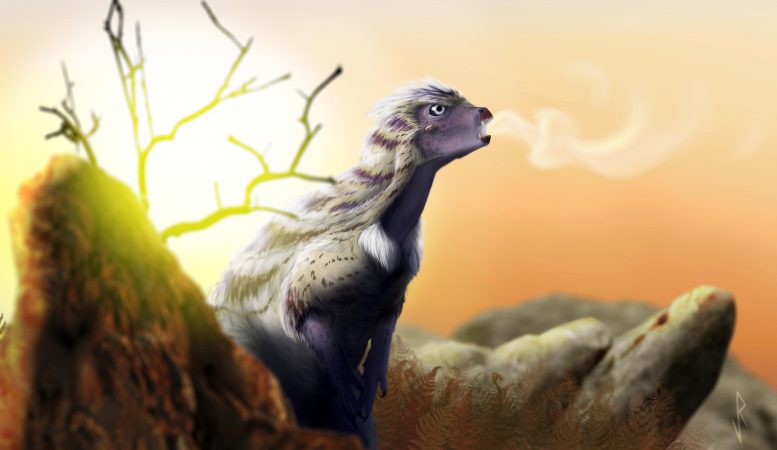
Life reconstruction of Heterodontosaurus vocalizing on a cool Jurassic morning. Credit: Viktor Radermacher
Using an exceptionally preserved fossil from South Africa, a particle accelerator, and high-powered x-rays, an international team including a University of Minnesota researcher has discovered that not all dinosaurs breathed in the same way. The findings give scientists more insight into how a major group of dinosaurs, including well-known creatures like the triceratops and stegosaurus, evolved.
The study is published in eLife, a peer-reviewed open access scientific journal for the biomedical and life sciences.
Not all animals use the same techniques and organs to breathe. Humans expand and contract their lungs. Birds have air sacs outside their lungs that pump oxygen in, and their lungs don’t actually move. For a long time, paleontologists assumed that all dinosaurs breathed like birds, since they had similar breathing anatomy. This study, however, found that Heterodontosaurus did not — it instead had paddle-shaped ribs and small, toothpick-like bones, and expanded both its chest and belly in order to breathe.
Using a well-preserved fossil and high-powered X-rays, an international team including a University of Minnesota researcher has discovered that not all dinosaurs breathed in the same way. This video shows a 3D digitization of the newly discovered Heterodontosaurus specimen, the oldest ancestor of dinosaurs such as Triceratops and Stegosaurus. Credit: Viktor Radermacher
Heterodontosaurus is the oldest dinosaur in the Ornithischian line, one of three major dinosaur groups that includes Triceratops, Stegosaurus, and other duck-billed dinosaurs. The other groups are sauropods, or longnecks, and theropods like the T-Rex.
“We actually have never known how these [Ornithischians] breathed,” said Viktor Radermacher, lead author of the study and a Ph.D. student in the University of Minnesota’s Department of Earth and Environmental Sciences. “The interesting thing is that Heterodontosaurus is the ancestor of this group and it has these [newly discovered] pieces of anatomy, but its descendants don’t. What that means is that Heterodontosaurus is a missing link between the ancestors of dinosaurs and the bigger, charismatic species we know. This gives us a whole bunch of information and fills in some pretty glaring gaps in our knowledge of the biology of these dinosaurs.”
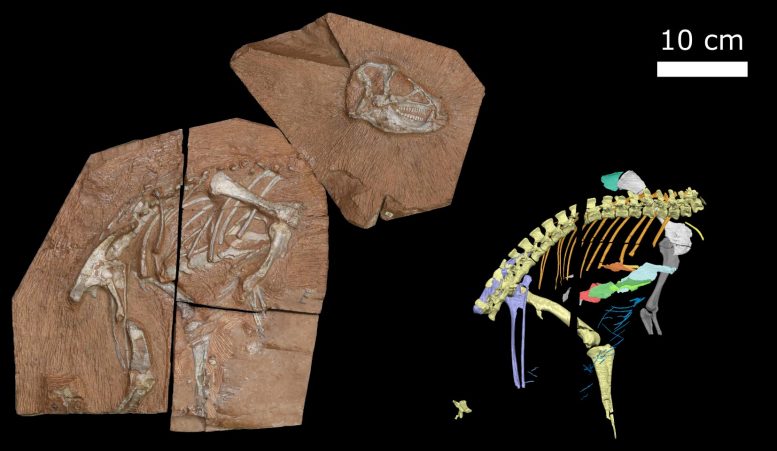
The newly discovered Heterodontosaurus tucki specimen (left), along with the researchers’ digital reconstruction of the fossil (right), shows the dinosaur’s unusual paddle-shaped ribs and small, toothpick-like bones. Credit: Viktor Radermacher
The researchers analyzed the new Heterodontosaurus specimen with high-powered X-rays generated from a synchrotron — a giant, donut-shaped particle accelerator that spins electrons at the speed of light — at the European Synchrotron Radiation Facility (ESRF) in France. Using those X-rays, they were able to digitally reconstruct the skeleton and identify the dinosaur’s unique features.
“The takeaway message is that there are many ways to breathe,” Radermacher said. “And the really interesting thing about life on Earth is that we all have different strategies to do the same thing, and we’ve just identified a new strategy of breathing. This shows that utilizing dinosaurs and paleontology, we can learn more about the diversity of animals on Earth and how they breathe.”
For more on this discovery, read 200-Million-Year-Old Fossil Sheds Light on the Evolution of How Dinosaurs Breathed.
Reference: “A new Heterodontosaurus specimen elucidates the unique ventilatory macroevolution of ornithischian dinosaurs” by Viktor J Radermacher, Vincent Fernandez, Emma R Schachner, Richard J Butler, Emese M Bordy, Michael Naylor Hudgins, William J de Klerk, Kimberley EJ Chapelle and Jonah N Choiniere, 6 July 2021, eLife.
DOI: 10.7554/eLife.66036
In addition to Radermacher, the research team included Vincent Fernandez, an ESRF beamline scientist and X-Ray technician at the Natural History Museum, UK; Emma Schachner, an associate professor at Louisiana State University; Richard Butler, a professor of palaeobiology at the University of Birmingham, UK; Emese Bordy, an associate professor at the University of Cape Town, South Africa; Michael Naylor Hudgins, a grad student at the University of Alberta, Canada; William de Klerk, emeritus curator of the Department of Earth Sciences at Rhodes University in Makhanda, South Africa; Kimberley Chapelle, a postdoctoral fellow at the American Museum of Natural History in New York; and Jonah Choiniere, a professor of comparative palaeobiology at the University of the Witwatersrand, South Africa.
The research was funded by grants from South Africa’s National Research Foundation (NRF) and Department of Science and Technology (DST), the Palaeontological Scientific Trust, and the Durand Foundation for Evolutionary Biology and Phycology.

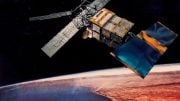
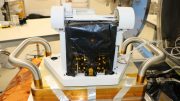
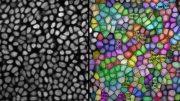
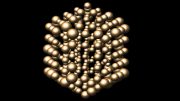


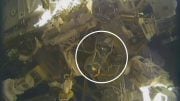
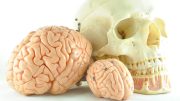
They know dinosaur breathed differently because today dinosaur breathed differently .American alligator breathed differently from a common caiman reason for that common caiman is a better swimmer both are alligator the heart different in modern crocodilian .modern crocodilian is just a modern form of spinosauridae this is reason why modern crocodilian is a dinosaur .duck bill dinosaur had unique uncinate processes different from any animal the gator is not made of bone I think some gator type mesoeucrocodylia is made of bone and today reptile the tuatara is different from bird unique uncinate processes that why they know maniraptoran is a bird not a dinosaur. Modern crocodilian is bird hip and lizard hip because they have moveable pubis hip in advance bird hip dinosaur they have same feature in 3 finger tetanuran dinosaur the pubis is fix only in the gator it move . In protosuchus type of dinosaur some pubis is not same size as dinosaur allso all birds is the same way .some protosuchus type is hard to see pubis clearly they breathed differently .protosuchus pubis hip is the same size as dinosaur. How dinosaur body is they can not have air sac they allso have very moveable femur leg not like birds and maniraptoran birds troodon bird oviraptor bird . Tetanuran dinosaur have a fourth trochanter that femur is very moveable and lack giant ankle what you find in birds and maniraptoran birds and oviraptor bird troodon bird .this is not a new story in gator the gator is a tyrannosaur in mesoeucrocodylia some fossil gator type mesoeucrocodylia have binocular vision like t.rex allso pig nose. dinosaur is not much different from the gator dinosaur had same breathing system as the gator it has to be in the modern crocodilian breathing system . Mesoeucrocodylia cheated when into water turn into super reptile major different is superior bite force of mesoeucrocodylia because it is harder to kill a animal in water .gator breathing system pretty good the Nile crocodile nose is not fuse like great mammal predator like dog cat to get more oxygen clearly modern crocodilianspinosauridae is high tech animal .why would reptile need more oxygen for the muscle if sopose to be cold blooded slow not as active as mammal worst gator spleen is advance were you see in horses a very fast mammal and a kidney is more advance than mammal active animal the mammal has a lot of acid build up the kidney is to solve that problem that why reptile kidney is not as advance as mammal because they are cold blooded .gator allso has flow through lungs to get more oxygen better than mammals and warm blooded heart works like a mammal and birds .clearly gator is warm blooded and dinosaur by those facts .gator esophagus works like human because gator simular to mammal. diaphragm animal bird lack diaphragm gator diaphragm is unique they are hepathic piston reptile .by scipionyx fossil dinosaur has a unique pubis for attachment of gator hepathic piston .clearly by dinosaur furcula well built arm missing finger they were very fast animal today fast land animal do not have furcula is because high pressure prevent bone from breaking because they are so fast .the problem with fast animal they need a lot of oxygen the body must change .gator allso a fast dinosaur most of the speed is inside not the legs it’s the monster centra backbone joints .most quadrupedal animal lack furcula even primitive form that is not fuse gator has one bone usual its two bone in birds its one bone because two bone fuse become furcula in reptiles two bones or one in fossil mammal remnants or none at all .dinosaur and gator advance pectoral girdle are convergent flight feature because they are very fast animal . Gator is just a better dinosaur they can sprawl like a lizard and walk bipedal primitive predator theropod could not sprawl .